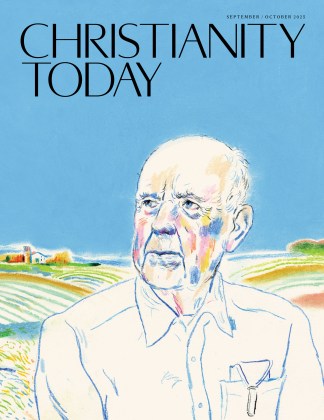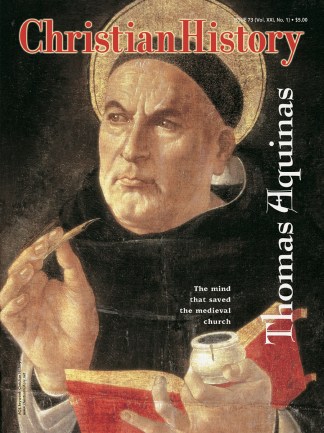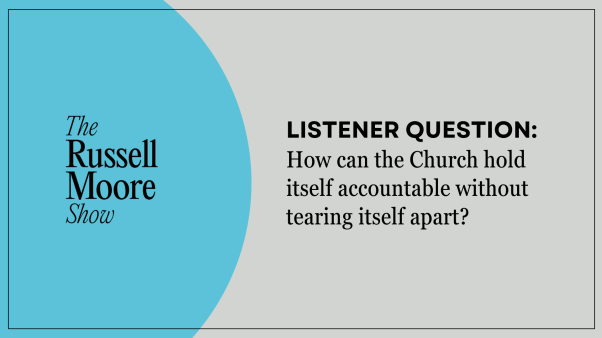In this series
Thomas Aquinas appeared at one of the most critical times in church history. Science, secularism, and human reason battered Christian theology. Thomas reconciled apparently contradictory forces, enabling the intellectual structure of the church to survive.
The great crisis
Augustine, bishop of Hippo from 395-430, taught that all people are corrupted by original sin and can be saved only by God’s grace according to his eternal, elective decree. Though scholars such as John Cassian and Gregory the Great modified his doctrines to make more room for human works, by the early twelfth century, the church accepted the essence of Augustine’s theology.
After the vibrant theological thinking of the fifth century, the church turned to the task of evangelizing pagan Europe, channeling its energies into missionary activity rather than theology. By 1000 the church had reached its goal.
At the same time, the advent of the High Middle Ages brought another era of fruitful theological scholarship, beginning with Anselm of Canterbury (c. 1033-1109), who defined the doctrine of the atonement.
Then, in the late eleventh century, crusaders brought a challenge from the Middle East that rocked the theological foundations of the Western church. In Muslim libraries, they had discovered Aristotle.
Aristotle did not begin with God and move downward to the material world, as Plato did. He began with the particulars, moving upward in increasing generalizations toward God. He assumed diversity, not unity, and incorporated the whole of existence into his system.
The great Islamic scholar Averroes, born in Cordoba, Spain, in 1126, became the foremost commentator on Aristotle. When a learned young professor in Paris, Peter Abelard, picked up the Aristotelian approach and applied it to the writings of the church fathers, the bomb exploded.
Abelard’s book Sic et Non (Yes and No) examined the writings of the early Christian Fathers and showed their discrepancies, contradictions, and disagreements on theological matters. While Abelard did not subject the Bible to the same type of criticism, he certainly opened the door to inquiry into Scripture and all the doctrines of the church.
Abelard’s critical approach aroused the ire of the respected scholar Bernard of Clairvaux, who charged Abelard with making faith, which Augustine said was a gift of divine grace, only a matter of opinion. Bernard claimed that Abelard had taken away the certitude of Christian salvation and thus undermined the whole of Christian theology.
With the bitter exchange between these two men, the war was on. Students and professors in medieval universities took sides on the issues, and lively and enthralling debates ensued. But the medieval church tottered on the brink of collapse, for at this point, no one was sure what Christians believed, why they believed it, or how they should define their belief.
Putting it together
Thomas undertook the awesome task of resolving this problem. No one else had dared.
The Aristotelians would not accept the old Augustinian views, lest science and reason be stifled. The Augustinians would not accept the Aristotelian view, lest faith be undermined and salvation become a merely intellectual matter. Thomas set out to bring both sides together in a reasonable synthesis.
His two great works, Summa contra Gentiles and Summa Theologica, became the most complete statement of belief in all Christian theology to that day, and, to a large degree, to this day. Only Calvin’s Institutes of the Christian Religion approach Thomas’s thorough and complete treatment of doctrine.
Thomas had plenty of critics. Aristotelians charged that he had not gone far enough in vindicating science and reason. Augustinians, especially Franciscans, thought he had gone much too far and sacrificed the sovereignty of God. Thomism was not accepted fully in the Roman Catholic church until the sixteenth-century Council of Trent.
Thomas, however, was undaunted. He labored to achieve the conclusions of Augustinian theology, in which he truly believed, by using the methodology of Aristotelianism, in which he also believed. Although this “Thomistic synthesis” has been compared to a theological house of cards, he essentially accomplished his objective.
The following examples of Thomas’s distinctive thought highlight the breadth and depth of his arguments.
Apologetics
Thomas is most remembered for his five-fold apology for the existence of God. All of his five ways involved empirical observation, an Aristotelian tool.
For instance, Thomas observed that everything is in a process of change. By reasoning that every change is produced by some cause, and that a thing cannot be at the same time cause and effect, he arrived at the fact that God is the ultimate cause of all things.
Second, continuing the idea of cause and effect, Thomas reasoned that there must be an efficient cause for all things that exist, and that a sequence of such efficient causes exists in the natural world. Behind all causes producing effects must lie an ultimate first efficient cause, which is God.
Third, God is the ultimate necessary cause, for there must be one cause that lacks the possibility of not being.
Fourth, by observing that there exists a gradation in things (such as things becoming more or less hot), there must be something that is the ultimate degree of all things and thus the cause of gradation.
Last, the governing and operating of the universe points to an intelligent force guiding it to its ultimate end.
Christian apologists still widely use his five-fold proof of the existence of God, though they do not always note the source of the arguments.
Revelation, grace, and providence
The use of reason, based on observation of empirical data, continued into all aspects of Thomas’s theological system. Reason could only proceed so far, though, and when it reached the end of its potential, Thomas taught that the Christian must rely on revelation.
This blending of reason and revelation allowed Thomas to synthesize Aristotelianism with Augustinianism, but it also alienated him from extremists. Averroists (radical Aristotelians) thought his use of revelation betrayed science. Franciscans, especially John Duns Scotus, thought his use of reason compromised God’s eternal decrees, wisdom, and power.
Contrary to criticism, however, Thomas did not abandon the idea of divine sovereignty. He modified the straightforward Augustinian doctrine of predestination, which was accepted completely by the Franciscans, by teaching that God gives to his people the “habit of grace,” in which they can approach God and perform acceptable works.
The Christian must then persevere in good works by God’s grace. Christians who fail to persevere cannot be saved.
Thomas attempted to harmonize this emphasis on good works, which began as early as Gregory the Great in the late sixth century, with the Augustinian doctrine of salvation by grace alone. He wanted to preserve both the church’s tradition regarding meritorious good works and Augustine’s doctrine of salvation by grace.
Thomas steered a course much closer to Augustine in regard to God’s sovereign governing of the universe. He asserted plainly that God is the governor and provider of all things: “He who believes that everything comes about by chance does not really believe in the existence of God. No one, however, can be found so foolish as not to believe that natural things are governed, provided for, and arranged by God when they happen in a certain order and at definite times.”
What Thomas observed in the natural realm, he applied to the physical and spiritual universe: God arranges and governs all things. No Reformation leader could have stated the matter more definitely.
Atonement
Two views of Christ’s atonement clashed in Thomas’s day. Anselm saw the atonement as a satisfaction for the sins of God’s people. Peter Abelard claimed the atonement was essentially an example of love drawing people to Christ.
Thomas affirmed that the atonement had a profound exemplary effect on the people of God, but he strongly emphasized the substitutionary nature of Christ’s work. The atonement, he taught, was not only an example for us to follow, but a remedy for sin. Christ’s death erased the stain of sin, paid for the offense against God, and negated the power of sin in our lives, enabling us to live a new life.
“I reply,” wrote Thomas in his Summa Theologica, “that a proper satisfaction comes about when someone offers to the person offended something which gives him a delight greater than the hatred of the offense. Now Christ by suffering as a result of love and obedience offered to God something greater than what might be exacted in compensation for the whole offense of humanity.”
This analysis of the atonement placed Thomas much more on the side of traditional, conservative Christian theology than the rationalist school of Abelard.
Transubstantiation
Regarding transubstantiation, Thomas again defended traditional ideas as defined by the Fourth Lateran Council in 1215. He taught that consecrated Communion bread and wine were changed in very substance into the body and blood of Christ while retaining the “accidental” appearance of bread and wine.
In other words, the priest changed the bread and wine into the actual body and blood of Christ, but the elements retained the appearance and taste of bread and wine. This distinction between substance and accident came from Aristotle.
It is misleading to project this concept back into the early church, because early Fathers lacked the philosophical categories to make it work. Nonetheless, the Council of Trent would later declare, “Since Christ our Redeemer said that that which he offered under the appearance of bread was truly his body, it has therefore always been held in the Church of God, and this holy Synod now declares anew, that through consecration of the bread and wine there comes about a conversion of the whole substance of the bread into the substance of the body of Christ our Lord, and of the whole substance of the wine into the substance of his blood. And this conversion is by the Holy Catholic church conveniently and properly called transubstantiation.”
Evaluation
Thomas’s work has aroused both awed admiration and virulent opposition. Mystics and humanists complained that it was too complicated and impersonal. Protestants disliked the accommodation to Aristotelianism and the reliance on philosophical arguments rather than on Scripture. Vastly different viewpoints compete yet today.
Thomas would probably agree that, in spite of his best efforts, it was beyond him to capture the Transcendent with words or to define the Undefinable. But as God’s obedient servant he performed, by the help of divine grace, the work of his calling.
J. David Lawrence is professor of history at Lipscomb University, Nashville, Tennessee.
Copyright © 2002 by the author or Christianity Today/Christian History magazine. Click here for reprint information on Christian History.











